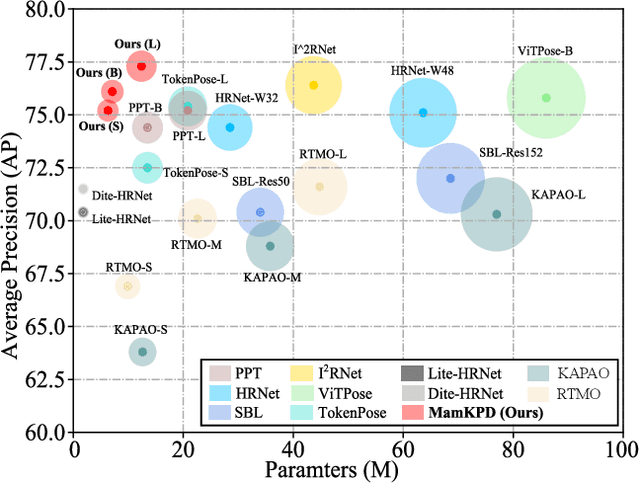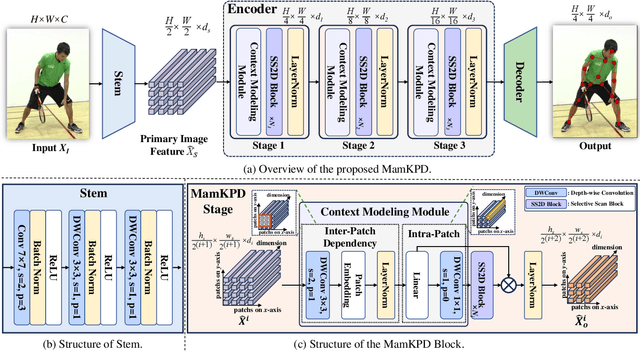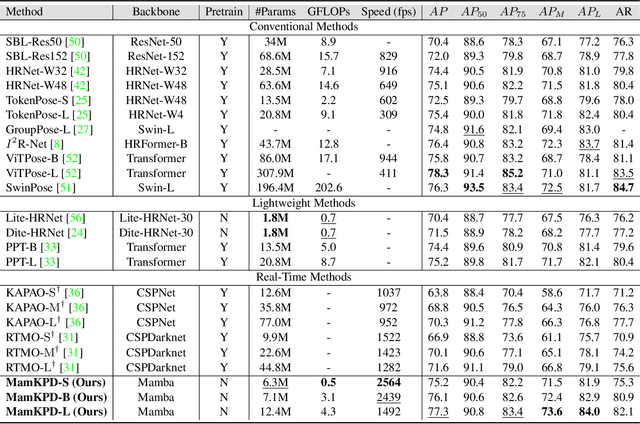Hui Kang
DINO-Detect: A Simple yet Effective Framework for Blur-Robust AI-Generated Image Detection
Nov 18, 2025Abstract:With growing concerns over image authenticity and digital safety, the field of AI-generated image (AIGI) detection has progressed rapidly. Yet, most AIGI detectors still struggle under real-world degradations, particularly motion blur, which frequently occurs in handheld photography, fast motion, and compressed video. Such blur distorts fine textures and suppresses high-frequency artifacts, causing severe performance drops in real-world settings. We address this limitation with a blur-robust AIGI detection framework based on teacher-student knowledge distillation. A high-capacity teacher (DINOv3), trained on clean (i.e., sharp) images, provides stable and semantically rich representations that serve as a reference for learning. By freezing the teacher to maintain its generalization ability, we distill its feature and logit responses from sharp images to a student trained on blurred counterparts, enabling the student to produce consistent representations under motion degradation. Extensive experiments benchmarks show that our method achieves state-of-the-art performance under both motion-blurred and clean conditions, demonstrating improved generalization and real-world applicability. Source codes will be released at: https://github.com/JiaLiangShen/Dino-Detect-for-blur-robust-AIGC-Detection.
Joint Resource Management for Energy-efficient UAV-assisted SWIPT-MEC: A Deep Reinforcement Learning Approach
May 06, 2025Abstract:The integration of simultaneous wireless information and power transfer (SWIPT) technology in 6G Internet of Things (IoT) networks faces significant challenges in remote areas and disaster scenarios where ground infrastructure is unavailable. This paper proposes a novel unmanned aerial vehicle (UAV)-assisted mobile edge computing (MEC) system enhanced by directional antennas to provide both computational resources and energy support for ground IoT terminals. However, such systems require multiple trade-off policies to balance UAV energy consumption, terminal battery levels, and computational resource allocation under various constraints, including limited UAV battery capacity, non-linear energy harvesting characteristics, and dynamic task arrivals. To address these challenges comprehensively, we formulate a bi-objective optimization problem that simultaneously considers system energy efficiency and terminal battery sustainability. We then reformulate this non-convex problem with a hybrid solution space as a Markov decision process (MDP) and propose an improved soft actor-critic (SAC) algorithm with an action simplification mechanism to enhance its convergence and generalization capabilities. Simulation results have demonstrated that our proposed approach outperforms various baselines in different scenarios, achieving efficient energy management while maintaining high computational performance. Furthermore, our method shows strong generalization ability across different scenarios, particularly in complex environments, validating the effectiveness of our designed boundary penalty and charging reward mechanisms.
UAV-assisted Joint Mobile Edge Computing and Data Collection via Matching-enabled Deep Reinforcement Learning
Feb 11, 2025Abstract:Unmanned aerial vehicle (UAV)-assisted mobile edge computing (MEC) and data collection (DC) have been popular research issues. Different from existing works that consider MEC and DC scenarios separately, this paper investigates a multi-UAV-assisted joint MEC-DC system. Specifically, we formulate a joint optimization problem to minimize the MEC latency and maximize the collected data volume. This problem can be classified as a non-convex mixed integer programming problem that exhibits long-term optimization and dynamics. Thus, we propose a deep reinforcement learning-based approach that jointly optimizes the UAV movement, user transmit power, and user association in real time to solve the problem efficiently. Specifically, we reformulate the optimization problem into an action space-reduced Markov decision process (MDP) and optimize the user association by using a two-phase matching-based association (TMA) strategy. Subsequently, we propose a soft actor-critic (SAC)-based approach that integrates the proposed TMA strategy (SAC-TMA) to solve the formulated joint optimization problem collaboratively. Simulation results demonstrate that the proposed SAC-TMA is able to coordinate the two subsystems and can effectively reduce the system latency and improve the data collection volume compared with other benchmark algorithms.
HSI: A Holistic Style Injector for Arbitrary Style Transfer
Feb 05, 2025Abstract:Attention-based arbitrary style transfer methods have gained significant attention recently due to their impressive ability to synthesize style details. However, the point-wise matching within the attention mechanism may overly focus on local patterns such that neglect the remarkable global features of style images. Additionally, when processing large images, the quadratic complexity of the attention mechanism will bring high computational load. To alleviate above problems, we propose Holistic Style Injector (HSI), a novel attention-style transformation module to deliver artistic expression of target style. Specifically, HSI performs stylization only based on global style representation that is more in line with the characteristics of style transfer, to avoid generating local disharmonious patterns in stylized images. Moreover, we propose a dual relation learning mechanism inside the HSI to dynamically render images by leveraging semantic similarity in content and style, ensuring the stylized images preserve the original content and improve style fidelity. Note that the proposed HSI achieves linear computational complexity because it establishes feature mapping through element-wise multiplication rather than matrix multiplication. Qualitative and quantitative results demonstrate that our method outperforms state-of-the-art approaches in both effectiveness and efficiency.
UAV Virtual Antenna Array Deployment for Uplink Interference Mitigation in Data Collection Networks
Dec 09, 2024



Abstract:Unmanned aerial vehicles (UAVs) have gained considerable attention as a platform for establishing aerial wireless networks and communications. However, the line-of-sight dominance in air-to-ground communications often leads to significant interference with terrestrial networks, reducing communication efficiency among terrestrial terminals. This paper explores a novel uplink interference mitigation approach based on the collaborative beamforming (CB) method in multi-UAV network systems. Specifically, the UAV swarm forms a UAV-enabled virtual antenna array (VAA) to achieve the transmissions of gathered data to multiple base stations (BSs) for data backup and distributed processing. However, there is a trade-off between the effectiveness of CB-based interference mitigation and the energy conservation of UAVs. Thus, by jointly optimizing the excitation current weights and hover position of UAVs as well as the sequence of data transmission to various BSs, we formulate an uplink interference mitigation multi-objective optimization problem (MOOP) to decrease interference affection, enhance transmission efficiency, and improve energy efficiency, simultaneously. In response to the computational demands of the formulated problem, we introduce an evolutionary computation method, namely chaotic non-dominated sorting genetic algorithm II (CNSGA-II) with multiple improved operators. The proposed CNSGA-II efficiently addresses the formulated MOOP, outperforming several other comparative algorithms, as evidenced by the outcomes of the simulations. Moreover, the proposed CB-based uplink interference mitigation approach can significantly reduce the interference caused by UAVs to non-receiving BSs.
MamKPD: A Simple Mamba Baseline for Real-Time 2D Keypoint Detection
Dec 02, 2024



Abstract:Real-time 2D keypoint detection plays an essential role in computer vision. Although CNN-based and Transformer-based methods have achieved breakthrough progress, they often fail to deliver superior performance and real-time speed. This paper introduces MamKPD, the first efficient yet effective mamba-based pose estimation framework for 2D keypoint detection. The conventional Mamba module exhibits limited information interaction between patches. To address this, we propose a lightweight contextual modeling module (CMM) that uses depth-wise convolutions to model inter-patch dependencies and linear layers to distill the pose cues within each patch. Subsequently, by combining Mamba for global modeling across all patches, MamKPD effectively extracts instances' pose information. We conduct extensive experiments on human and animal pose estimation datasets to validate the effectiveness of MamKPD. Our MamKPD-L achieves 77.3% AP on the COCO dataset with 1492 FPS on an NVIDIA GTX 4090 GPU. Moreover, MamKPD achieves state-of-the-art results on the MPII dataset and competitive results on the AP-10K dataset while saving 85% of the parameters compared to ViTPose. Our project page is available at https://mamkpd.github.io/.
Channel-Wise Contrastive Learning for Learning with Noisy Labels
Aug 14, 2023



Abstract:In real-world datasets, noisy labels are pervasive. The challenge of learning with noisy labels (LNL) is to train a classifier that discerns the actual classes from given instances. For this, the model must identify features indicative of the authentic labels. While research indicates that genuine label information is embedded in the learned features of even inaccurately labeled data, it's often intertwined with noise, complicating its direct application. Addressing this, we introduce channel-wise contrastive learning (CWCL). This method distinguishes authentic label information from noise by undertaking contrastive learning across diverse channels. Unlike conventional instance-wise contrastive learning (IWCL), CWCL tends to yield more nuanced and resilient features aligned with the authentic labels. Our strategy is twofold: firstly, using CWCL to extract pertinent features to identify cleanly labeled samples, and secondly, progressively fine-tuning using these samples. Evaluations on several benchmark datasets validate our method's superiority over existing approaches.
Unleashing the Potential of Regularization Strategies in Learning with Noisy Labels
Jul 11, 2023Abstract:In recent years, research on learning with noisy labels has focused on devising novel algorithms that can achieve robustness to noisy training labels while generalizing to clean data. These algorithms often incorporate sophisticated techniques, such as noise modeling, label correction, and co-training. In this study, we demonstrate that a simple baseline using cross-entropy loss, combined with widely used regularization strategies like learning rate decay, model weights average, and data augmentations, can outperform state-of-the-art methods. Our findings suggest that employing a combination of regularization strategies can be more effective than intricate algorithms in tackling the challenges of learning with noisy labels. While some of these regularization strategies have been utilized in previous noisy label learning research, their full potential has not been thoroughly explored. Our results encourage a reevaluation of benchmarks for learning with noisy labels and prompt reconsideration of the role of specialized learning algorithms designed for training with noisy labels.
PADDLES: Phase-Amplitude Spectrum Disentangled Early Stopping for Learning with Noisy Labels
Dec 07, 2022



Abstract:Convolutional Neural Networks (CNNs) have demonstrated superiority in learning patterns, but are sensitive to label noises and may overfit noisy labels during training. The early stopping strategy averts updating CNNs during the early training phase and is widely employed in the presence of noisy labels. Motivated by biological findings that the amplitude spectrum (AS) and phase spectrum (PS) in the frequency domain play different roles in the animal's vision system, we observe that PS, which captures more semantic information, can increase the robustness of DNNs to label noise, more so than AS can. We thus propose early stops at different times for AS and PS by disentangling the features of some layer(s) into AS and PS using Discrete Fourier Transform (DFT) during training. Our proposed Phase-AmplituDe DisentangLed Early Stopping (PADDLES) method is shown to be effective on both synthetic and real-world label-noise datasets. PADDLES outperforms other early stopping methods and obtains state-of-the-art performance.
 Add to Chrome
Add to Chrome Add to Firefox
Add to Firefox Add to Edge
Add to Edge